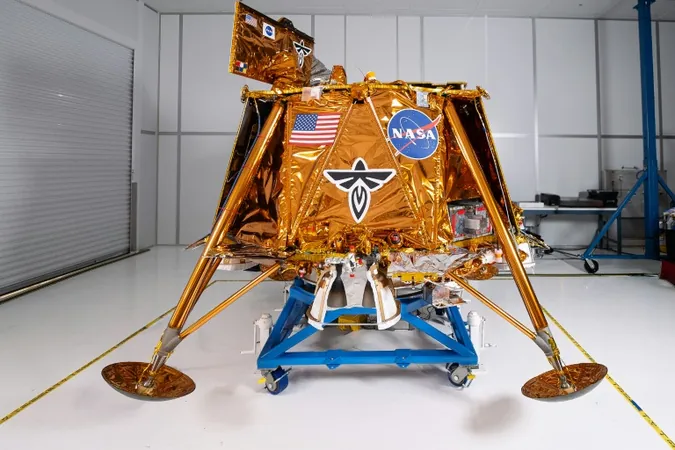
US and Japanese Lunar Landers Set for Groundbreaking Launch Together
2025-01-14
Author: Arjun
US and Japanese Lunar Landers Set for Groundbreaking Launch Together
In an unprecedented venture, two lunar landers from US and Japanese companies are preparing to share a ride to the Moon aboard a SpaceX Falcon 9 rocket, marking a significant collaboration in the era of commercial space exploration.
Scheduled for liftoff at 1:11 AM (0611 GMT) on Wednesday from the Kennedy Space Center in Florida, the mission sees optimal weather conditions predicted for the launch. On board the Falcon 9 are Firefly Aerospace’s Blue Ghost and Japan’s ispace Resilience, which will deploy a micro rover. This launch symbolizes a shift where private enterprises take center stage in space exploration, previously dominated by government agencies.
The new wave of companies is challenging the traditional space age paradigm, aiming to replicate past successes in lunar landing. Notably, Texas-based Intuitive Machines became the first private company to successfully land on the Moon last year, setting a precedent that both Firefly and ispace aim to build on.
Historically, soft landings on the lunar surface were solely accomplished by a select group of well-funded government organizations since the Soviet Union's initial landing back in 1966. However, the landscape is changing, with multiple US companies now participating in NASA’s Commercial Lunar Payload Services (CLPS) program. This initiative is designed to reduce costs while fostering a burgeoning lunar economy.
The ambitious Artemis program aims to establish a sustained human presence on the Moon by the end of this decade. It seeks to leverage these commercial partnerships to deliver essential hardware at significantly lower costs compared to traditional government-led missions.
"Every milestone we achieve will provide us with invaluable data for subsequent missions and will ensure that the United States and our global partners remain at the forefront of space exploration," commented Firefly Aerospace CEO Jason Kim in anticipation of the launch. He excitedly added, "Firefly is a go for launch. Let's go ghost riders in the sky!"
On the Japanese front, ispace has seen its first lunar landing attempt end in disaster, as it experienced a “hard landing” on its previous mission in April 2023. “We hope to send a message across Japan about the importance of challenging ourselves after enduring failure and learning from it,” said ispace founder and CEO Takeshi Hakamada, emphasizing the need to push forward despite setbacks.
The launch vehicle will deploy Blue Ghost first, approximately 30 minutes before Resilience. The two landers boast distinctive timelines for their lunar journeys. Blue Ghost is expected to reach its lunar location in about 45 days, ultimately aiming for a landing near Mons Latreille, a volcanic formation in Mare Crisium on the Moon's near side.
Dr. Maria Banks, a NASA scientist, highlighted that Blue Ghost carries ten NASA instruments for scientific exploration, investigating everything from Earth's magnetosphere to the unique characteristics of lunar dust and the Moon's internal structure. In addition to scientific pursuits, it also features technology demonstrations aimed at navigating and computing within the Moon’s challenging radiation environment.
Simultaneously, the Resilience lander plans to reach its target in Mare Frigoris, located in the Moon's far north, within a span of four to five months. Among its scientific payload is Tenacious, a micro rover developed by ispace-Europe, which is based in Luxembourg. This innovative rover is equipped with a high-definition camera and aims to collect lunar regolith—loose surface material—during its mission. Notably, it also carries a unique red "Moonhouse" designed by Swedish artist Mikael Genberg to add an artistic touch to the mission.
Despite their ambitious objectives, the success of both landers heavily relies on achieving a successful soft landing—a meticulous task facing numerous challenges. Spacecraft must adeptly maneuver around hazardous boulders and craters, as there is no atmosphere to support parachute landings; thrusters are the sole means for controlled descent.
Recent missions have underscored the importance of maintaining a stable landing position. For instance, Intuitive Machines' Odysseus landed in April 2024 but fell over, limiting its operational capabilities. Similarly, Japan's SLIM lander, which landed in March 2024, encountered difficulties by landing at an awkward angle, which compromised its solar panels and reduced its operational lifespan.
With these missions on the horizon, the stakes are high. The collaboration between US and Japanese companies not only signifies a new era in space exploration but also holds the potential to reveal incredible discoveries about our cosmic neighbor. Will they succeed in overcoming the challenges of space travel? Only time will tell!




 Brasil (PT)
Brasil (PT)
 Canada (EN)
Canada (EN)
 Chile (ES)
Chile (ES)
 Česko (CS)
Česko (CS)
 대한민국 (KO)
대한민국 (KO)
 España (ES)
España (ES)
 France (FR)
France (FR)
 Hong Kong (EN)
Hong Kong (EN)
 Italia (IT)
Italia (IT)
 日本 (JA)
日本 (JA)
 Magyarország (HU)
Magyarország (HU)
 Norge (NO)
Norge (NO)
 Polska (PL)
Polska (PL)
 Schweiz (DE)
Schweiz (DE)
 Singapore (EN)
Singapore (EN)
 Sverige (SV)
Sverige (SV)
 Suomi (FI)
Suomi (FI)
 Türkiye (TR)
Türkiye (TR)
 الإمارات العربية المتحدة (AR)
الإمارات العربية المتحدة (AR)